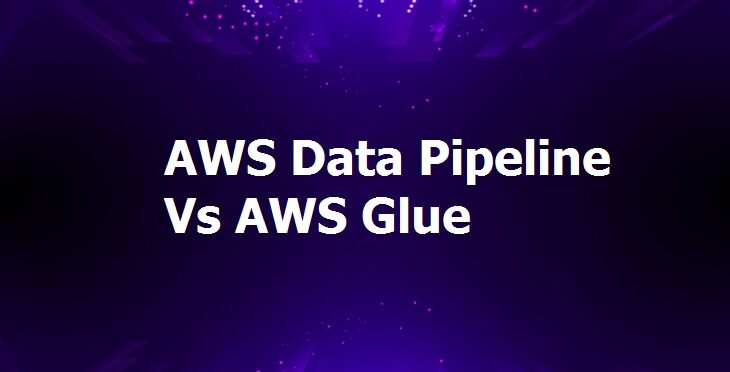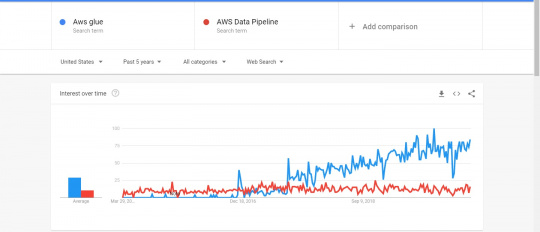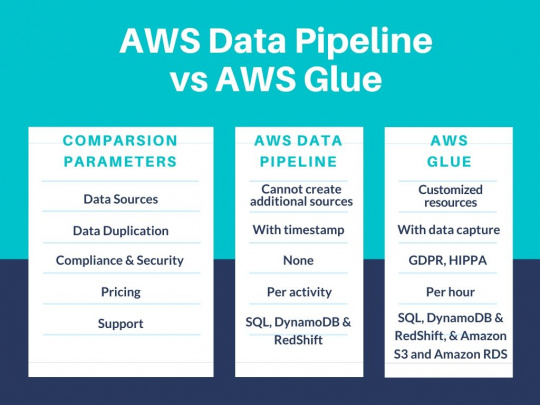Amazon Web Services are dominating the cloud computing and big data fields alike. In the last blog, we discussed the key differences between AWS Glue Vs. EMR.
In this blog, we will be comparing AWS Data Pipeline and AWS Glue. AWS Glue is one of the best ETL tools around, and it is often compared with the Data Pipeline.
Though the process and functioning of these tools are different, we will be comparing them through ETL (Extract, Transform, and Load) perspective.
AWS Data Pipeline Vs. AWS Glue: Complete Comparison
AWS Data pipeline is an AWS product that provides automation in data movement. It also ensures that once the first process is completed successfully, then only the next process begins without manual intervention. It comes under the "Data Transfer” category in big data.
AWS Glue is an AWS product that provides easier creation, transformation, and subsequently loading of the datasets. It is primarily an ETL (Extract, transform, Load) tool. It comes under the “Data Catalog” category in big data.
As per the above-mentioned chart, we can conclusively say that AWS Glue has been much more popular than AWS Data Pipeline in the past five years as far as Google searches go.
Also Read: AWS Data Pipeline vs Kinesis: What’s the Difference?
As a data transfer tool, you cannot create additional data sources in the AWS Data Pipeline. You have to work with the defined data sources.
But, on the other hand, AWS Glue allows you to create custom sources to connect the data that is not in sync with AWS.
AWS Data Pipeline allows the users to backup and duplicates the data through timestamp fields. With this, the developers can create databases for advanced stages.
In the case of AWS Glue, the developers can duplicate the data with the help of data capture methods for easier data transformations of duplicate data.
AWS Data Pipeline is not in compliance with security requirements like HIPPA, or GDPR. But, that doesn’t mean that you are using illegal practices.
It means you need to manage the checklists and all the necessary parameters at your end and not directly through the tool.
But, on the other hand, AWS Glue is certified with HIPPA and GDPR. Hence, whenever you have to submit the audit report, you can directly extract the data through the tool. And then present it to the authorities without much of a fuss.
The pricing models are different for both the AWS Data Pipeline and AWS Glue. AWS Data Pipeline charges on the basis of activities while AWS Glue charges plainly on hourly basis.
You can purchase the AWS Data Pipeline in two different payment methods as per your requirements.
These models are known as low-frequency models and high-frequency models. The low-frequency model costs you about $0.6 per month, while high frequency plans costs around $1 per month per activity.
You can also avail the free tier to get to know about the tool.
As for AWS Glue, you need to pay around $0.44 per hour per DPU. This leads to a $21 per day cost. It offers some freebies too. You can store the first million objects for free, and even the access for the first million instances is free.
In AWS Data Pipeline, you can create the data transformation schematics through JSON or through APIs too. And, you can connect the data through SQL, DynamoDB, and RedShift.
On the other hand, AWS Glue comes with predefined built-in transformations. The developers can easily create new files with python-based codes that are not AWS Glue structured.
AWS Glue also supports SQL, DynamoDB, and RedShift. But, its support goes beyond these, with Amazon S3 and Amazon RDS too.
Key Takeaways:
We can see that from the above-mentioned points that even though AWS Data Pipeline and AWS Glue are created for different purposes, their goals are quite similar.
Both of these tools have their pros and cons. It is up to you and your requirements to decide which one is more suited to your requirements.
Also Read:
AWS Glue Vs. Amazon EMR: Know the Difference
AWS Data Pipeline vs. Step Functions: How are the Two Different?







